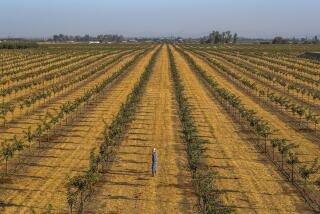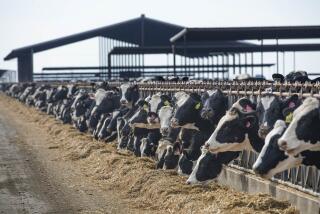Market-Based Farm Policy Asked in State
- Share via
SACRAMENTO — “Agriculture stands at a crossroads,” a leader of the California Farm Bureau Federation observed here last week as, on the other side of the country, Congress concluded work on farm debt-relief legislation and prepared to debate a new farm program to replace legislation expiring this year.
Drafting a new farm program provides an opportunity to move agriculture onto a new course, weaning it from heavy dependency on government price supports and orienting it toward greater responsiveness to market forces, said Bob L. Vice, vice president of the California Farm Bureau.
“It is no longer the producer’s right to decide to grow a crop and expect that a market will be there to buy it. . .,” Vice told a daylong briefing of the federation’s membership. “We have to identify a market and then produce for that market.”
Vice cited California’s dairy industry as a victim of overdependency on past subsidies. “It’s been too easy to produce milk for the government,” he said, “and that is why we have built up large stockpiles of powdered milk, butter and cheese. In the process, we have disregarded an important market right here in California--the market for cheese.”
Priced Out of Markets
Worse, especially for efficient Western growers, government supports for certain farm commodities have now priced California out of the world markets on which they became dependent during the expansive 1970s. The August, 1971, devaluation of the dollar, creation of billions of petro-dollars and readily available foreign credit for developing countries made U.S. farm products attractive abroad.
Those conditions, which produced an ever-expanding demand for agricultural exports, became the assumptions on which the present system of rigid price supports was based in 1981, with its inducements to increase production, observed Alex McCalla, a professor of agricultural economics at the University of California, Davis.
And yet, no sooner was that program adopted, Vice said, than “the market fell to pieces.”
Export commodities, which now account for a third of California’s total production acreage, peaked at $4.8 billion in 1981 ($44 billion nationally) but have been on a downward slide since, dropping to $3 billion ($38 billion nationally).
As the dollar regained its pre-devaluation strength in relation to other currencies and as government-supported prices exceeded world prices (sometimes subsidized by exporting countries), U.S. producers found themselves selling their crop to the government, swelling the nation’s inventory of surplus commodities.
Planned to Import Wheat
Despite enjoying the world’s most productive agriculture, America thus became the world’s high-cost producer--so high that, earlier this year, Minneapolis-based Cargill Inc., the world’s largest grain merchant, announced plans (since rescinded) to import wheat from Argentina because, even with transportation charges, it was cheaper than American.
In response, Western growers have become strong proponents of a market-oriented farm policy--its strongest exponent within the parent American Farm Bureau Federation, which favors a market-oriented farm policy, in principle, but with no specific timetable for phasing out government aid, as unsuccessfully urged by the California federation.
“We recognize that we will never completely end government involvement in farm programs,” Vice said, “but we believe that these so-called (government) safety nets should not keep every farmer in business.”
Part of the difficulty of fashioning a national policy, said Tim Wallace of the University of California Cooperative Extension and a former director of the California Department of Food and Agriculture, is that farms and growing conditions, and therefore needs, vary from region to region. Government’s role should be to attempt to coordinate production to meet demand, something he said individual farmers are incapable of doing.
“It’s logical and rational for each farmer to produce more,” Wallace explained, “but, en masse , it’s economic suicide.”
Restrictive Trade Policies
But the present system of rigid price supports, giving the secretary of agriculture little discretion, encourages production despite the fact that “most parts of the system are experiencing overcapacity,” said Lynn M. Daft of the Washington consulting firm of Abel, Daft & Earley.
That overcapacity is exacerbated by restrictive foreign trade policies, said Jean-Mari Peletier, a trade specialist with the California State World Trade Commission. For example, Japan, a natural trade partner of California, still has about 50 specific products subject to import quotas, Peletier said.
While a trade agreement between the two countries now allows American cherries into Japan, after fumigation, the crop can only enter after July 1; this effectively excludes California’s crop, which peaks a month earlier, she said. Nectarines, denied access as a potential carrier of the codling moth, an agricultural pest, may actually be barred, Peletier said, because of fears by Japanese peach producers that nectarines would reduce peach sales. Finally, she said, Japan requires that lettuce, which is equally susceptible to aphids on either side of the Pacific, must be fumigated before entry into Japan, which destroys the lettuce’s shelf life, she said.
California agriculture supports “tough language” encouraging the Reagan Administration to negotiate ends to foreign countries’ export subsidies and unfair trading practices, Peletier said. Yet, the Administration’s proposed “Agricultural Adjustment Act of 1985” “doesn’t do much in the area of trade to open access or increase exports,” said Henry J. Voss, president of the California federation.
Developing export markets is crucial for American agriculture, the university’s Wallace said, because the United States and its major trade partners constitute “mature” markets for food, characterized by no growth. Growth in demand for food will be strongest in the world’s poorest countries, where the birthrate--and thus the number of future stomachs to feed--is growing fastest. “This means that where the people are, the money is not,” he said.
Growth the Issue
“For agriculture, the most important issue over the next five or 10 years is world economic growth,” said Ross Korves, an economist with the American Farm Bureau Federation in Chicago. Overseas customers must earn foreign exchange, he explained, because “if they don’t make any money, they don’t buy any food from us. . . .
“If we want to see American agriculture go down the tubes, protectionism is the fastest way to do it,” Korves said.
Nonetheless, McCalla was among a number of the Sacramento speakers to express little optimism that the current farm debate will move agriculture down a new road. “What’s going to happen?” he asked. “I say, not very much.”
As Voss summed up the situation in a commentary to the California federation’s membership: “Many farmers have been operating under government programs for so long that they can’t bring themselves to move away from Big Brother and out into the real world of market competition. . . .
“We call ourselves independent, hardy individualists, entrepreneurs of the soil,” Voss continued. “It is time we proved that before it is too late. For some,” he acknowledged, “unfortunately, it already is.”
More to Read
Get the L.A. Times Politics newsletter
Deeply reported insights into legislation, politics and policy from Sacramento, Washington and beyond. In your inbox twice per week.
You may occasionally receive promotional content from the Los Angeles Times.










